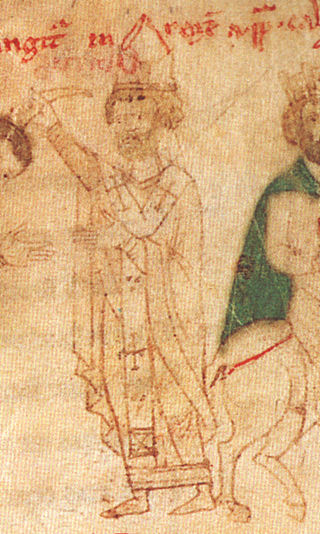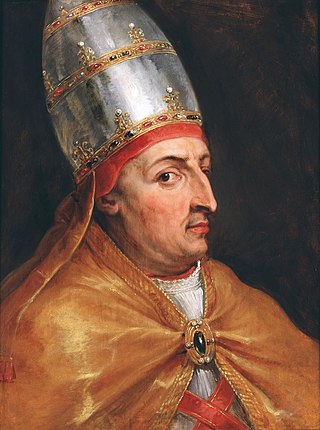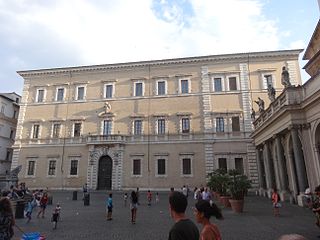The First Council of the Lateran was the 9th ecumenical council recognised by the Catholic Church. The first ecumenical council to be held in Western Europe & the first since the Great Schism of 1054, it was convoked by Pope Callixtus II in December 1122, immediately after the Concordat of Worms. The council sought to bring an end to the practice of the conferring of ecclesiastical benefices by people who were laymen, free the election of bishops and abbots from secular influence, clarify the separation of spiritual and temporal affairs, re-establish the principle that spiritual authority resides solely in the Church and abolish the claim of the Holy Roman Emperor to influence papal elections.

Pope Alexander VI was head of the Catholic Church and ruler of the Papal States from 11 August 1492 until his death in 1503. Born into the prominent Borgia family in Xàtiva in the Kingdom of Valencia under the Crown of Aragon, Rodrigo studied law at the University of Bologna. He was ordained deacon and made a cardinal in 1456 after the election of his uncle as Pope Callixtus III, and a year later he became vice-chancellor of the Catholic Church. He proceeded to serve in the Curia under the next four popes, acquiring significant influence and wealth in the process. In 1492, Rodrigo was elected pope, taking the name Alexander VI.

Pope Callixtus I, also called Callistus I, was the bishop of Rome from c. 218 to his death c. 222 or 223. He lived during the reigns of the Roman emperors Elagabalus and Alexander Severus. Eusebius and the Liberian catalogue list his episcopate as having lasted five years (217–222). In 217, when Callixtus followed Zephyrinus as Bishop of Rome, he started to admit into the Church converts from sects or schisms. He was killed for being Christian and is venerated as a saint and martyr by the Catholic Church.

Pope Callixtus II or Callistus II, born Guy of Burgundy, was the head of the Catholic Church and ruler of the Papal States from February 1119 to his death in 1124. His pontificate was shaped by the Investiture Controversy, which he was able to settle through the Concordat of Worms in 1122.

Pope Callixtus III, born Alfonso de Borgia, was head of the Catholic Church and ruler of the Papal States from 8 April 1455 to his death, in August 1458.

Year 1119 (MCXIX) was a common year starting on Wednesday of the Julian calendar.

Pope Nicholas V, born Tommaso Parentucelli, was head of the Catholic Church and ruler of the Papal States from 6 March 1447 until his death, in March 1455. Pope Eugene IV made him a cardinal in 1446 after successful trips to Italy and Germany, and when Eugene died the next year, Parentucelli was elected in his place. He took his name Nicholas in memory of his obligations to Niccolò Albergati.
Athleta Christi was a class of Early Christian soldier martyrs or military saints, of whom the most familiar example is probably Saint Sebastian. It also could be used to refer to Christians with exemplary martial prowess, especially when fighting against non-Christians or heretics.

Dum Diversas is a papal bull issued on 18 June 1452 by Pope Nicholas V. It authorized King Afonso V of Portugal to fight, subjugate, and conquer "those rising against the Catholic faith and struggling to extinguish Christian Religion"—namely, the "Saracens (Muslims) and pagans" in a militarily disputed African territory. The document consigned warring enemies that lost to "perpetual servitude". This and the subsequent bull, issued by Nicholas in 1455, gave the Portuguese what they saw as moral justification to freely acquire slaves along the African coast by force or trade. The edicts are thus seen as having facilitated the Portuguese slave trade from West Africa and as having legitimized the European colonization of the African continent.
William I, called the Great, was Count of Burgundy from 1057 to 1087 and Mâcon from 1078 to 1087. He was a son of Reginald I, Count of Burgundy and Alice of Normandy, daughter of Richard II, Duke of Normandy. William was the father of several notable children, including Pope Callixtus II.

Bartolomeo Sacchi, known as il Platina after his birthplace of Piadena, was an Italian Renaissance humanist writer and gastronomist, author of what is considered the first printed cookbook.

Jaime or James of Portugal, also known as James of Coimbra, James of Lusitania, was a Portuguese infante (prince) of the House of Aviz, and a bishop and cardinal of the Roman Catholic Church.

Reginald II was the count of Burgundy, Mâcon, Vienne and Oltingen. He was born in 1061 as the eldest son of William I, Count of Burgundy and brother to Stephen I, Count of Burgundy, his successor, as well as to Pope Callixtus II.
Stephen I, known as the Rash, was Count of Burgundy, Mâcon and Vienne from 1097 until his death.

The 1464 papal conclave, convened after the death of Pope Pius II, elected as his successor cardinal Pietro Barbo, who took the name Paul II.

The 1119 papal election was, of all the elections currently considered legitimate by the Roman Catholic Church, the smallest papal election of the twelfth century.
William II of Burgundy, known as the German, was a French nobleman.

The 1458 papal conclave, convened after the death of Pope Callixtus III, elected as his successor Cardinal Enea Silvio Piccolomini who took the name Pius II.

With a long history as a vantage point for anti-popes forces threatening Rome, Viterbo became a papal city in 1243. During the later thirteenth century, the ancient Italian city of Viterbo was the site of five papal elections and the residence of seven popes and their Curias, and it remains the location of four papal tombs. These popes resided in the Palazzo dei Papi di Viterbo alongside the Viterbo Cathedral intermittently for two decades, from 1257 to 1281; as a result, the papal palace in Viterbo, with that in Orvieto, are the most extensive thirteenth-century papal palaces to have survived.

The Palazzo San Callisto is a Baroque palace in the Trastevere neighborhood of Rome and one of the extraterritorial Properties of the Holy See. The original Palazzo is located in the Piazza di Santa Maria in Trastevere, the later extensions have their entrance in Piazza di San Callisto. The entire complex is one of the areas of the Holy See regulated by the 1929 Lateran Treaty signed with the Kingdom of Italy. As such it has extraterritorial status.













